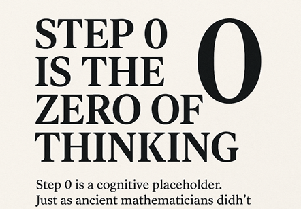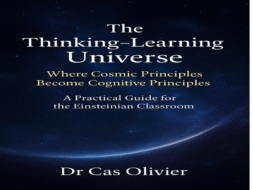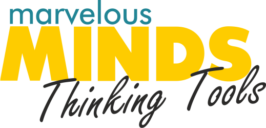I was honoured to have the article on Step Zero being published in the November Edition of the STEM Magazine
The first article in the STEM Magazine was in January 2025: Brain-Based Learning: Addressing Modern Educational Concerns
This insight stems from the previous blog: Why Learners Who Practise Sums Still Struggle in Exams
Here is more helpful information Traditional Teaching Needs a Cognitive Defibrillator
For a deeper understanding, read this blog alongside: Why is Step 0 is a game-changer for mankind?
Read HERE Why Learners Who Practise Sums Still Struggle in Exams.
Read this blog to understand:
- The role of Step 0 in Step 0 in Grade 5 Fractions: Pausing to See the Path
- The Power of Step 0 in Algebra: Seeing the Path Before the First Step
- Step 0: The Unseen First Step in Essay Writing
- Step 0 for Headmasters — Sparking Purposeful Professional Development
Have you ever wondered why innovation often comes from outside the system.
Just as ancient mathematicians didn’t know they were missing zero, we too remain unaware that our thinking is incomplete without Step 0.
This pre-plan is the missing strand in the DNA of conceptual planning. Step 0’s a virtual pause in the mind where time feels suspended. It’s not part of linear cause-effect thinking; it simply emerges. It is a mental moment of alignment or readiness—and it precedes any conscious thought or planning. It is the root source of insight, creativity, and the Aha moment. Only after Step 0 completes itself do neurochemical reactions begin. These are responses to insight, not causes of it.
Step 0 doesn’t just appear from nowhere — it’s triggered by a felt sense of where you might be going. Not a fully formed goal, but a “visible-invisible end in mind”:
- Visible — because you sense a direction, a mood, or an outcome.
- Invisible — because you don’t yet have the concrete details or the exact shape of the final product.
At the heart of real thinking lies a quiet pause: Step 0 is the cognitive placeholder for thinking—that first, unspoken moment where our minds hover, sensing an emerging direction without fully forming it.
Before structure, before argument, even before a clear goal—there’s this flicker of intention: a faint north star that guides the mind, a felt end in mind that’s both visible (you sense a purpose or mood you want to land on) yet invisible (you don’t yet know how you’ll get there). That’s the true ignition of Step 0.
What Really Happens in Step 0?
- A sense of direction emerges
You might feel, “This essay should leave the reader unsettled about homework,” or “This argument should feel hopeful.” That sense isn't yet words—it's a magnetic whisper pulling your thinking. - Chaos precedes order
You jot scraps—facts, feelings, half-images, stray phrases—not to build yet, but to notice what resonates. - Meaning-making begins
In this unstructured gathering, ideas cluster, connections spark, and a shape starts to settle—even before you outline it.
Step 0: Writing with a “Visible–Invisible End in Mind”
| Stage | What Happens |
|---|---|
| Trigger | A hazy sense or feeling of where the essay wants to go: tone, emotion, impact. |
| Exploration | Scribbles, fragments, adjectives, images, memories—anything that responds to that flicker. |
| Emergence | Patterns begin to surface—key ideas, vivid words, emotional anchor points that become the essay’s engine. |
That fits beautifully into the Step 0 frame:
- In maths, that might be “I think this will end with finding an angle” even before knowing which theorem will get you there.
- In essay writing, it could be “I want the reader to feel uneasy about this issue” before you’ve chosen your examples or structure.
- In creative writing, it might be “This story will end bittersweet” before knowing the plot beats.
It’s like a mental north star — hazy enough to keep possibilities open, clear enough to give your brainstorming a magnetic pull.
When Step 0 happens, time stands still—yet ideas rush in. It’s not thinking fast or slow, it is that pause before action when the brain weaves invisible threads into insight.”
Step 0 is not what happens before creativity — it is creativity. It’s the moment when nothing seems to be happening, but everything is aligning. It’s the invisible process that leads to the visible Aha.
During Step 0, the brain enters a suspended state — time, as we know it, becomes virtual, nonlinear, or even irrelevant. Only after Step 0 completes itself do neurochemical reactions begin. These are responses to insight, not a cause of it. Dopamine is released which gives the brain a reward, reinforcing the clarity or breakthrough.
The laws of clocks no longer apply; instead, the brain reorganizes meaning behind the curtain of consciousness
Step 0 is not a preparation phase. It is a hidden mental event — a cognitive pause that precedes clarity, understanding, and action. It’s the moment before the moment — the quiet swirl where seemingly unrelated ideas begin to self-organize.
Step 0 is not caused by effort, struggle, or desire. It is not something the brain “tries” to do. It happens spontaneously—like a spark in a quiet mind—without the need for external triggers or buildup. The brain doesn’t consciously decide to enter Step 0. Much like REM sleep or intuition, it’s unplanned but essential.
Most people speak about creativity and Aha moments as sudden bursts of brilliance. But these flashes are simply the surfacing of Step 0.
This phase feels timeless — and for good reason. While the outer world continues ticking, the brain enters a nonlinear, immersive state. Thought patterns reconfigure. Meaning emerges. But on the outside? It appears as “nothing happening.”
In Step 0, chronological time is suspended. We don't measure it by seconds — we feel it in insight. This matches what many describe during creative flow:
- “I lost track of time.”
- “Time stood still.”
- “Suddenly, it just clicked.”
This aligns with the idea of the chronosensor — the brain’s built-in sense of time, rhythm, and sequencing. During Step 0, this chronosensor shifts into a virtual mode, allowing us to temporarily escape the clock and reframe ideas.
Step 0s don't happen in a neat, linear order. They often occur in series and/or parallel, triggered by a question, a problem, a metaphor — or nothing at all, which reflects the true nature of the brain: It thrives in pattern, rhythm, and abstraction, not steps and plans.
Step 0 Is the Brain’s spontaneous creative Launchpad where time bends, logic loosens, and meaning forms itself.
Let us move away from treating thinking as a conveyor belt — and embrace it as a dance of inner alignment. Let us teach not just what to think, but when not to think — and allow Step 0 to do its invisible work.
There is Emotional Resonance and endorphins may follow when the insight feels relieving or joyful. Serotonin reflects the sense of calm, confidence, and meaning after understanding emerges.
The world calls it creativity or an Aha moment. But what really happens is Step 0—an invisible, spontaneous inner alignment. During Step 0, time collapses. There is no ticking clock. The result is a surge of clarity, followed by emotional and chemical responses in the body. Step 0 is the origin, and hormones are merely the echoes.
Only after Step 0 completes itself do neurochemical reactions begin. These are responses to insight, not a cause of it. Dopamine is released which gives the brain a reward, reinforcing the clarity or breakthrough.
There is Emotional Resonance and endorphins may follow when the insight feels relieving or joyful. Serotonin reflects the sense of calm, confidence, and meaning after understanding emerges.
The world calls it creativity or an Aha moment. But what really happens is Step 0—an invisible, spontaneous inner alignment. During Step 0, time collapses. There is no ticking clock. The result is a surge of clarity, followed by emotional and chemical responses in the body. Step 0 is the origin, and hormones are merely the echoes.
As in maths, Zero was always there — yet it was only when its existence was recognized that mathematics was transformed. Mathematics changed forever the moment zero was understood — not because it was newly invented, but because its existence was finally seen.
Zero was always waiting in the background of mathematics — but only once it was recognized did it revolutionize the discipline
Just as early mathematicians couldn’t place zero on the number line, we’ve never known where to place Step 0 in our thinking — yet both are essential foundations that quietly hold the entire system together.
Just as ancient minds couldn’t imagine the power of zero, our planning instincts remain blind to Step 0 — the cognitive placeholder that makes everything else possible.
Yet throughout history, great inventors and thinkers like Archimedes and Newton intuitively discovered and perfected what we now call Step 0 — they paused, positioned their minds, and explored the context before attempting to solve.
The Hidden Pitfall That Became the DNA of Human Problem-Solving skills
For over a century, human problem-solving has been built on a flawed assumption.
Pólya Gave Us a Sequence — But Step 0 Gives Us a Compass
Pólya’s four steps tell us how to proceed.
But Step 0 tells us where we are — and how to begin.
Just as zero made place value, algebra, calculus, and computing possible…
Step 0 makes deep learning, flexible thinking, and intelligent action possible.
It’s not an extra.
It’s not a warm-up.
It is that moment of pausing, connecting, and framing the situation. The brain suspends immediate action and starts connecting cues, drawing on memory, logic, and experience. This is not yet diagnosis (Step 1)—it’s framing the situation. Step 0 is cognitive. It happens in the mind before action begins. Step 0 itself is not the information — it’s what the brain does with it. It is a/the mental game plan.
It’s the silent architecture of the thinking brain.
And it’s time we teach it — as the most powerful step no one sees.
George Pólya’s celebrated the four-step method:
(1. Understand the problem, 2. Devise a plan, 3. Carry out the plan, 4. Look back) became the gold standard in classrooms, business strategy, and academic models.
The entire model skips the brain’s most essential move — the cognitive alignment that must happen before Step 1.
This omission has shaped generations of mechanical problem-solvers who jump into action without first orienting their thinking. They “understand the problem” only on the surface, then rush into execution — unprepared, unfocused, and unable to adapt.
Why Step 0 Changes the Thinking Game
- It clears the noise, connects the dots.
- It combats cognitive blindness — the fixation on surface detail.
- It activates executive memory — for planning, sequencing, and regulating.
- It builds mental adaptability.
- It connects scattered information.
- It dislodges stuck thinking.
- It shakes the kaleidoscope, not to act but to see differently.
- Step 0 is not about solving at all.
- It’s about undoing, de-framing, unhooking from what you thought was the problem — until the insight reveals itself.
- It is a moment to de-frame and to reframe.
- It is orientation in complexity.
- It switches the brain from reaction to reflection — the birthplace of strategic clarity
When Step 0 is ritualised, it empowers learners to enter complexity with awareness, not confusion. This can be done by a putting learners in a Step 0 corner.
Freud described the preconscious as a mental layer where thoughts linger just outside awareness, ready to be brought into consciousness. That’s exactly where Step 0 lives.
It’s the space where ideas, impressions, and intuitions begin to organise themselves before action.
Pre-planning is not part of Pólya’s method — it precedes it. It is not about solving. It is not about clarity of the question.
Step 0 is about understanding the context before engaging with the problem. It is the mental discipline of positioning the mind to think, not just to act.
It includes:
- Sensing the terrain, not just spotting keywords
- Priming executive memory, not just recalling procedures
- Activating the whole brain, not just the solving parts
- Locating yourself inside the situation, not just outside the task
- Pause and position. “Where am I in relation to this task? What type of thinking is needed?”
- Clarify the given — but don’t get trapped by it. “What is obvious… and what might be hidden beneath?”
- Sense the invisible structure. “What patterns, relationships, or types of problems does this resemble?”
- Extrapolate from the given — not toward an answer but toward meaning. “What does this tell me about what might come next — not in the solution, but in the context?”
- Tunes the brain for clarity, focus, and context.
- The moment of tilling, clearing, and enriching the mental soil so ideas can take root.
- It includes framing the context.
- It clears the fog.
Step 0 is not planning for models, diagrams, or strategies, it paves the way for models, diagrams and strategies to be planned for. Step 0 isn’t passive reflection — it’s cognitive alignment.
It’s the mental equivalent of a pilot scanning the skies before take-off. The pilot just fires up the engines and accelerates down the runway. Step 0 is the pre-flight checklist of the brain: sensing conditions, positioning systems, and preparing for what may come.
Step 0 is like consulting a compass and scanning the environment before reading the map. Reading the map may not be a good idea on a rainy day.
Step 0 is a musician tuning the instrument before playing. It’s not part of the performance — but without it, the notes are off. In learning it’s preparing the soil before planting the seeds. Throwing seeds on unprepared ground rarely works.
It’s surveying the crime scene before collecting clues. Jumping straight to evidence without understanding context risks misinterpretation.
And most of all: it gives the brain time to build cognitive scaffolds for itself before it starts.
In solving maths problems Step Zero or the pre-plan is still a placeholder.
👉 Step 0 holds mental structure.
It frames what follows — even though it “says” nothing itself. Zero has no value — yet it defines value. its position changes everything: Compare 7 vs. 70 vs. 700.
👉 Step 0 appears empty — yet it determines how deeply a learner engages the problem. It’s the difference between jumping into 7… or preparing for 700.
Step zero drives true innovation — in learning, business and design.
The iPhone didn’t emerge from refining existing ideas. It came from redefining the landscape before even choosing the problem to solve.
And that’s the power of Step 0:
It doesn’t just ask, “What’s the answer?” It asks, “What world are we in — and what world do we want to build?”
At the time, mobile phone companies were locked in a result-driven loop:
“Make the phone smaller.”
“Add a better keypad.”
“Improve call quality.”
“Extend battery life.”
This was classic Step 1 thinking — solving problems within an existing framework.
Incremental. Linear. Expected.
“What is a phone, really?”
“What is the relationship between communication, mobility, and creativity?”
“What if a phone wasn’t a phone at all, but a pocket-sized digital life center?”
But Steve Jobs didn’t start with the problem. He started with the context.
This wasn’t a solution looking for a problem.
It was cognitive repositioning — the kind of thinking that doesn’t begin with execution, but with deep contextual awareness.
Jobs wasn’t just solving. He was reframing.
That’s Step 0 thinking in action.
He paused before the plan.
He disrupted before he built.
He sensed what others couldn’t see because they were already locked into their “Step 1.”
Why Step 0 Shakes the Kaleidoscope:
- Old Pattern: Jump into action → Get stuck → Backtrack → Panic.
- New Pattern (via Step 0): Pause → Frame the challenge → Organize thoughts → Strategize with clarity
What Makes It Step 0?
- No tools in hand yet
- No physical action
- Just brainwork: quiet pause, pattern recognition, mental modelling, prioritising
- Outcome: A clearer path forward
Step 0 reorganizes the fragments of prior knowledge, assumptions, and intentions into a new, clearer pattern - forever....





